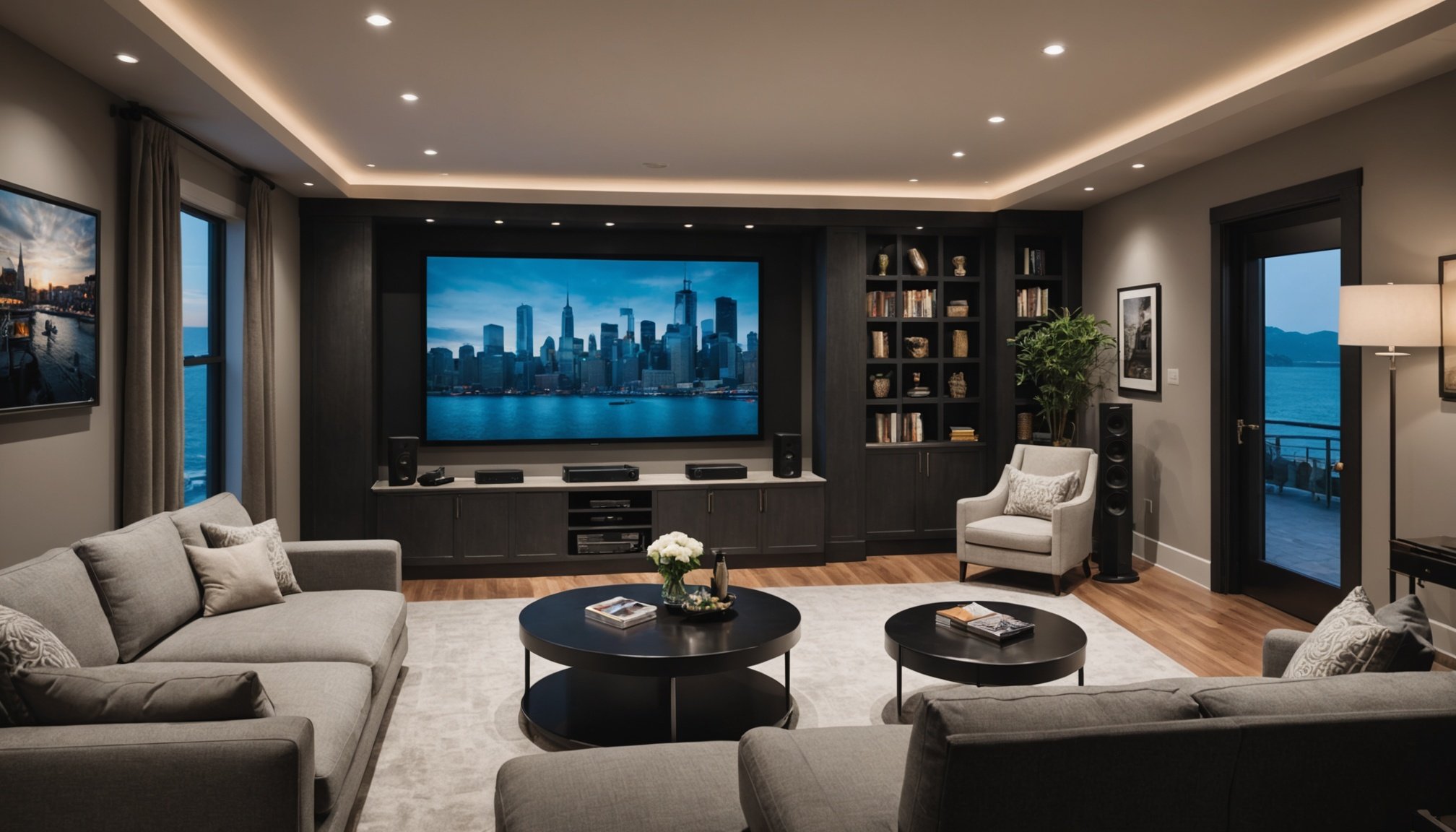Transform Your Living Room: The Ultimate Guide to Creating a Smartphone-Operated Surround Sound Home Theater Experience
Setting the Stage: Why You Need a Home Theater
Imagine transforming your living room into a cinema room where every movie night feels like a trip to the movies, and every gaming session is an immersive adventure. A well-crafted home theater system can elevate your entertainment experience, making your living room the heart of your home. Here’s why you should consider investing in a smartphone-operated surround sound home theater.
A home theater is more than just a collection of speakers and a screen; it’s about creating an immersive audio and visual experience that draws you into the action. With the rise of smart home technology, controlling your home theater with your smartphone is now easier than ever. This guide will walk you through the steps to create a top-notch home theater that you can operate seamlessly with your smartphone.
Topic to read : Maximize Your Smart Home: The Complete Guide to Monitoring Solar Panel Energy Through Your Smartphone
Choosing the Right Components: The Heart of Your Home Theater
When it comes to building a home theater, the right components are crucial. Here are the key elements you need to consider:
Soundbar or Speaker System
The soundbar or speaker system is the backbone of your home theater. For a surround sound experience, you can opt for a soundbar with wireless rear speakers or a full-fledged speaker system.
Topic to read : Mastering Smart Home Harmony: Your Ultimate Smartphone Manual for Personalizing and Automating Daily Routines
- Soundbars: Options like the Sonos Arc Ultra or the Flexus Core 200 offer exceptional sound quality and ease of use. The Sonos Arc Ultra, for instance, supports Dolby Atmos, has automatic room calibration, and integrates seamlessly with other Sonos devices for a comprehensive home theater setup[1].
- Speaker Systems: If you prefer a more traditional setup, consider a system with front left and right speakers, a center channel, surround speakers, and a subwoofer. This setup allows for greater customization and can be expanded with ceiling speakers for a Dolby Atmos experience[5].
Display and Screen
Your display is just as important as your audio system. Here are a few things to keep in mind:
- TV or Projector: Choose a 4K TV or a projector that supports the latest video standards like HDR and Dolby Vision. Ensure it has enough HDMI inputs to connect all your devices, such as a Blu-ray player, gaming console, and streaming devices[2][5].
Control and Automation
Smart home automation can make your home theater experience even more enjoyable.
- Smart Hubs: Devices like the Harmony Hub allow you to control multiple entertainment devices with a single remote or through a smartphone app. This can include dimming lights, powering on the TV, and adjusting the sound settings with just a few taps[2].
Setting Up Your Home Theater: A Step-by-Step Guide
Setting up your home theater requires some planning and attention to detail. Here’s a step-by-step guide to help you get started:
Plan Your Space
Before you start buying equipment, consider the layout of your room.
- Seating and Viewing Angle: Ensure that your seating is positioned for the best viewing angle. For an immersive experience, the screen should be at eye level, and the speakers should be angled towards the listeners[5].
- Lighting: Proper lighting can enhance the viewing experience. Consider using smart blinds and color-changing smart lights to create the perfect ambiance[2].
Positioning Your Speakers
The placement of your speakers is critical for optimal sound quality.
- Front Speakers: Place them at ear level, angled towards the listeners.
- Center Channel: This speaker should be placed below or above the screen to ensure clear dialogue.
- Surround Speakers: Position them slightly behind the seating area to create an immersive surround sound experience.
- Subwoofer: This can be placed in a corner to amplify the bass response[5].
Connecting Your Devices
Ensure all your devices are compatible and connected properly.
- HDMI Inputs: Use HDMI 2.1 inputs for 4K/120 fps content and features like Dolby Atmos and Dolby Vision passthrough.
- Wireless Connectivity: Use Bluetooth, Wi-Fi, or proprietary wireless technologies to connect your speakers and other devices. For example, the Sonos Arc Ultra supports AirPlay 2, Spotify Connect, and Bluetooth[1].
Calibration and Optimization
Calibration is key to ensuring your home theater sounds its best.
Automatic Room Calibration
Many modern soundbars and AV receivers come with automatic room calibration features.
- Sonos Arc Ultra: This soundbar includes an excellent automatic room calibration feature that adjusts the sound settings based on your room’s acoustics[1].
- AV Receivers: These often come with calibration tools that use a microphone to measure the sound from each speaker and adjust the levels, distances, and frequency response accordingly[5].
Manual Adjustments
Sometimes, manual adjustments are necessary for the perfect sound.
- Center Channel Volume: Ensure the center channel volume is slightly higher than the front speakers to avoid drowning out dialogue[4].
- Crossover Settings: Adjust the crossover settings to ensure a smooth transition between the speakers and the subwoofer[4].
Smart Home Integration: The Future of Home Theaters
Smart home integration can take your home theater to the next level.
Smartphone Control
With smartphone apps, you can control every aspect of your home theater.
- Sonos App: The Sonos app allows you to adjust EQ settings, calibrate the soundbar, browse music services, and play music via Wi-Fi. You can also transfer sound to Sonos headphones for an immersive experience[1].
- Harmony Hub App: This app lets you control multiple devices, create custom activities, and adjust settings with ease[2].
Additional Smart Features
Consider adding other smart features to enhance your experience.
- Smart Lights: Color-changing smart lights can create a dynamic ambiance.
- Smart Blinds: These can be automated to dim the lights during movie nights.
- Virtual Reality Systems: For an ultimate gaming experience, consider integrating VR systems[2].
Practical Insights and Actionable Advice
Here are some practical tips to help you get the best out of your home theater:
Budgeting
- Balance Your Budget: Ensure you allocate your budget wisely across all components. A good sound system is crucial, but so is a high-quality display[4].
Compatibility
- Check Compatibility: Make sure all your devices are compatible with each other. For example, if you have an Amazon Fire Stick and a Google Home, ensure they can communicate seamlessly[2].
Maintenance
- Regular Updates: Keep your devices updated with the latest firmware to ensure optimal performance[3].
Comparative Analysis: Top Soundbars for Your Home Theater
Here’s a comparative analysis of some top soundbars that can be the centerpiece of your home theater:
| Soundbar | Key Features | Price Range | Compatibility |
|---|---|---|---|
| Sonos Arc Ultra | Dolby Atmos, Automatic Room Calibration, AirPlay 2, Spotify Connect, Bluetooth | Premium | Compatible with Sonos subwoofers and Era speakers[1] |
| Flexus Core 200 | Dolby Atmos, Dialogue Boost, Optional Sub and Surround Speakers | Sub-$500 | Compatible with Flexus Sub 100 and Surround 100 speakers[1] |
| Sony Bravia Theater Quad | 8K HDR, 4K 120, Dolby Vision, IMAX Enhanced, DTS:X | Premium | Compatible with wireless speakers, supports VRR, ALLM, and SBTM for gaming[1] |
Creating a smartphone-operated surround sound home theater is a rewarding project that can significantly enhance your entertainment experience. Here are some final thoughts to keep in mind:
- Quality Over Quantity: Invest in high-quality components rather than opting for cheaper alternatives.
- Customization: Tailor your setup to your specific needs and preferences.
- Expansion: Choose systems that allow for easy expansion, such as adding more speakers or integrating new technologies.
As you embark on this journey, remember that the key to a great home theater is not just the equipment, but how well it is integrated and optimized for your space. With the right components, smart home integration, and careful calibration, you can transform your living room into a cinema room that offers the best home theater experience possible.
Quotes and Anecdotes
- “The Sonos Arc Ultra is a game-changer. With its automatic room calibration and seamless integration with other Sonos devices, it creates an incredibly immersive Dolby Atmos experience,” says a satisfied Sonos user.
- “I was amazed by how easy it was to set up my home theater using the Harmony Hub. Now, I can control everything from my smartphone, making movie nights a breeze,” shared a homeowner who recently automated their home theater.
By following this guide, you’ll be well on your way to creating a home theater that not only enhances your entertainment experience but also becomes the centerpiece of your living room. Happy building











